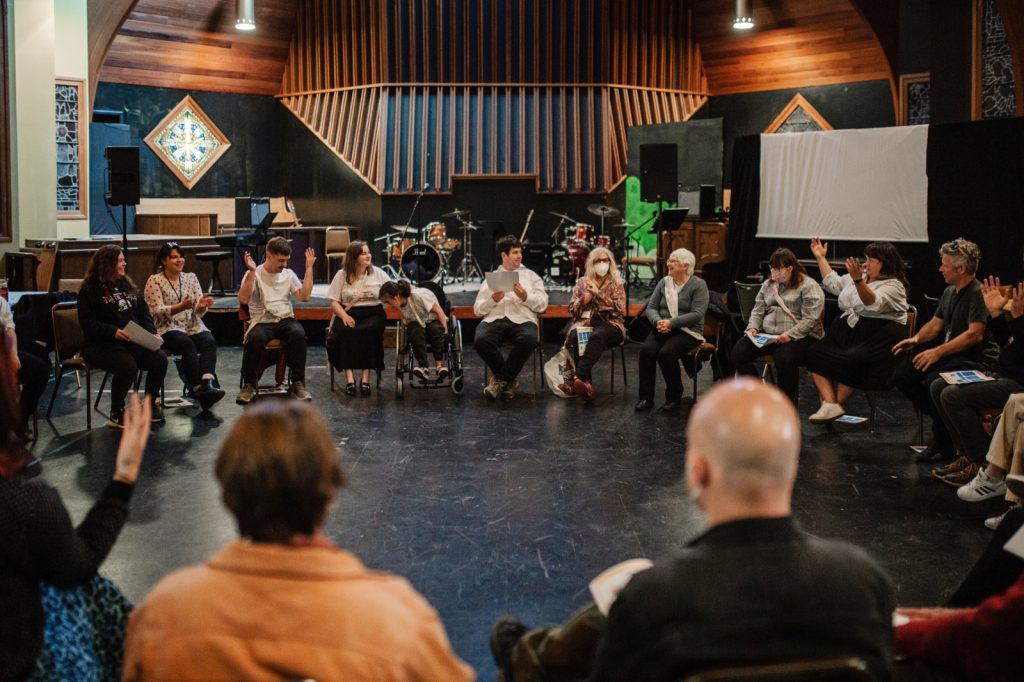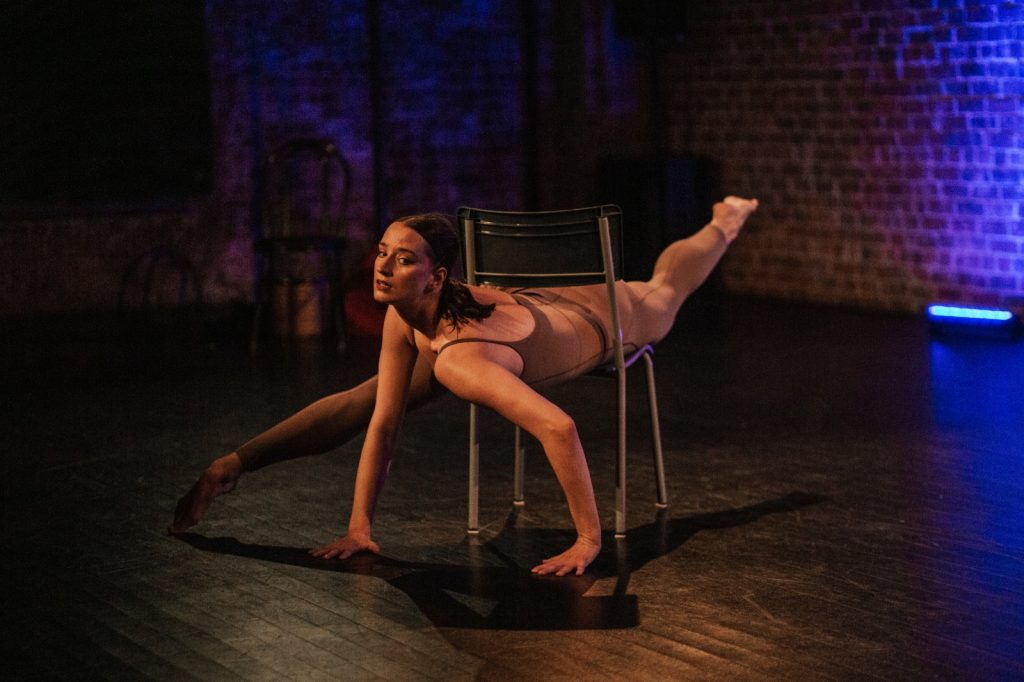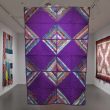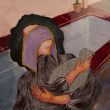Arts Atlantic Symposium

Japanese artist Tomo Ingalls stands at the centre of the Tompkins Studio Hall within the Saint John Arts Centre. It is pitch black except for a soft spotlight hitting the performance area. A 220lb circle of recycled clay is surrounding her, with a larger circle of participants sitting in front of hanging tapestries splattered with pigment.
Slowly, Ingalls begins to push out from the pile of clay until she reaches a participant on the outer rim, hands them the clay, and then returns to the circle and repeats. The clay doesn’t fight back, but the weight of its presence remains.
From October 21 to 23, 2022, ArtsLink NB, a provincial organization meant to unify New Brunswick’s arts and culture sector, hosted its inaugural Arts Atlantic Symposium, in Menagoesg (Saint John, NB). The theme of the symposium, Future Possible, was inspired by keynote speaker Mireille Eagan, who is the contemporary curator of The Rooms, and editor of Future Possible: An Art History of Newfoundland and Labrador (Goose Lane 2021).
Over the course of three days, a series of installations, panels, talks, and workshops explored how Atlantic Canada’s artists plan to greet the future while addressing past failures.

Photo: Naomi Studio, submitted by ArtsLink NB.
The Arts Atlantic Symposium was originally planned for 2020, with professional event coordinator Mark Burnett’s vision, but was waylaid due to COVID-19. Through the collective effort of a small and passionate team of professionals and volunteers, the symposium finally took place this past fall. It was guided by a committee of ArtsLink NB Directors, and relaunched with the efforts of visual artist and curator Sarah Jones, and musician and professional tubist Gabrielle Carruthers.
A number of challenging conversations happened over the symposium. To those communities most vulnerable, a smile and nod wasn’t going to cut it.
I felt this concern as I observed the panel “Building Momentum,” in which a group of Disabled artists, writers, educators, and arts workers discussed disability access in the arts community. The panel was co-facilitated by Alexis Bulman and Gerald Beaulieu, and featured a discussion with Raven Davis, April Hubbard, Vie Jones, and Aislinn Thomas.
The panel title reminded me of Ingalls’s performance, as the issue with momentum is that it can be cancelled out by an opposing force. As I listened to the panelists’ experiences, I felt their exasperation with the lack of support provided to them. Each speaker entered the conversation from a different viewpoint, with a different accessibility requirement, but with a similar goal of wanting to build a more accessible arts community. “True equity costs money,” says Thomas, an interdisciplinary artist.
That future felt visceral, closer, as I listened to Mi’kmaw artist Starlit Simon’s speech during her “Resistance, Reciprocity and Roadkill” talk with fellow Mi’kmaw artist and mentor Tara Francis, at the Saint John Arts Centre. Simon’s memorable laughter filled the room, while Francis meditatively worked on a piece of porcupine quill art, softly smiling as she listened to Simon’s stories, at times stopping to amusingly quip back. “We should live with what the land wants, not what your boss wants,” says Simon.
It was invigorating to listen to stories from an Indigenous perspective, learning about the logistics of porcupine roadkill—how much time you have to reach the animal’s body, how long the porcupine can last, how to honour the body—and seeing the works of art created by a practice that Simon and Francis are trying to keep alive and outside the hands of cultural appropriators.
In a way, Simon and Francis’ panel felt like a conversation I would have with my own family, a circle of Chinese immigrants playing mahjong, laughing and sharing stories outside the realm of the colonial White narrative and aesthetic that I still see in many shows by White curators (even though they try to include diverse experiences). Simon and Francis’ talk exemplified why we need more underrepresented communities leading events instead of being a small addition to larger conversations.
Artist and educator Alex Turgeon explored early queer back-to-the-land communities in his talk, “From Here to There and Back, Again: Reflections on BOONIES,” at the Saint John Arts Centre. Before the internet, rural queers had to connect through grassroots mail publications, sharing everything from tips and tricks to living off the land to compu-poetry, contributing to rural queer worldbuilding.
In addition to workshops and talks, the Arts Atlantic Symposium also featured installations throughout Saint John, including: Jalianne Li’s 100x1x2 with Collectif HAT and Xavier Richard, plus the separate installation, 100x1x2xMirrorball with FRACA. COVID-19 provided unique challenges and Li, as an artist and dancer, filmed and published online her dance improvisations from her travels and during lockdown.
This culminated in a site-adaptive performance (former) and installation (latter) that melded physical and digital into a sort of meta-performance, with moving projections of her dance videos overlapping with her on-site performance.
In a similar vein, artist Jordan Hill explored the uncanny valley between real and fake with his installation Horizontal Vertigo. Simulating the act of staring out of a vehicle while on the highway, and looking at the treeline at high speed, the installation projected over two inkjet-printed white screens allowed it to wander and weave between the spaces.
Artist Camille-Zoé Valcourt-Synnott’s piece Dear Hiring Committee made visible the invisible labour of being a professional artist: the grant writing and job application process. While accepted submissions culminate in shows and other public-facing opportunities, much of the artist’s time is spent applying for funding in order to make work. Valcourt-Synnott’s installation projects a recorded video of a cover letter that the artist works on, and follows it through its creation and editing process.
Another public installation featuring the Erasure Art Collective (Shauntay Grant and Tyshan Wright) captured a different type of editing process in their live installation Blackout, exhibited at Jones Gallery. Grant and Wright produce new narratives from slave ads by using black pigment to cover words through the poetic technique of erasure. I watched as they spoke quietly to each other, painting black acrylic over a grotesque ad until only this text remained: be GIRL. 23d June, 1800. [sic]. Prior to the Erasure Art Collective’s performance, I was horrified at the existence of the slave ads and shocked to see them hung on a gallery wall.
Grant notes they never erase the same text twice, accepting the potential for imperfection. Once you black out a text, “you can’t get it back,” says Grant.
Many of the symposium events ran concurrently. I opted to try and see as many events as possible by underrepresented communities. Grant’s words became all too clear as I witnessed the pain left behind by settler-colonialism, ableism, sexism, racism, homophobia, and more. I had the privilege of being able to hear the experiences of people from different communities that struggle to live within the boundaries erected by a White capitalist society.
Still, the road is paved with the injustices that allow it to exist in the first place. “Roadside Attraction,” a panel discussion facilitated by writer and curator Christiana Myers featured artists Rebecca Blankert, Nat Cann, Hailey Guzik, Chantal Khoury, Alana Morouney, Christina Thompson, and KC Wilcox. The panel addressed some of the unsettling architecture and culture surrounding New Brunswick as a tourist “picture province,” and the arbitrary values that we imbue objects to perpetuate a myth of cultural significance. At the centre of the conversation lies the highway, the contradiction that guides us to our destination, but also hinders us from seeing what lies beyond.
















Leave a Reply